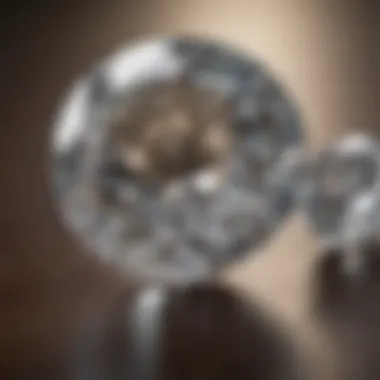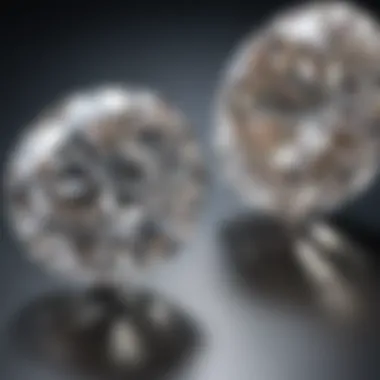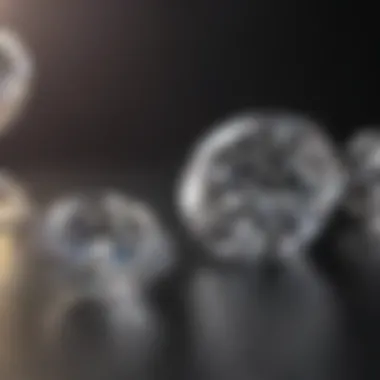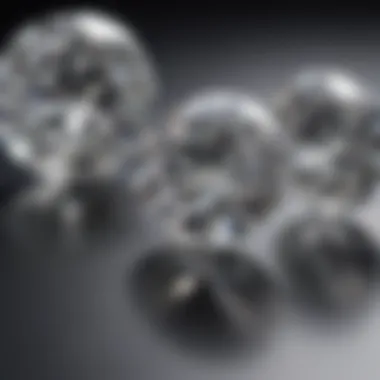I1 vs I2 Diamond Clarity: Key Differences Explained


Intro
Diamonds have captivated humanity for centuries, not just for their beauty but also for their complex characteristics. Among these traits, clarity plays a crucial role in defining a diamond’s overall quality. Specifically, the distinctions between I1 and I2 diamond clarity grades can significantly affect a diamond's appearance, value, and desirability.
In the realm of diamonds, clarity refers to the presence of internal or external flaws, known as inclusions and blemishes, respectively. Understanding the differences between I1 and I2 grades is essential for anyone looking to invest in or appreciate these precious stones fully. This article navigates through the subtleties that set apart these clarity levels, drawing insights that are not just academic but practical for collectors, jewelers, and enthusiasts alike.
Gems are more than just decorative items; they tell stories, hold memories, and even symbolize emotions. Therefore, when diving into the characteristics and evaluations of diamonds, it’s vital to appreciate the finer details that make each grade unique. With this foundation in mind, let’s begin our exploration of what truly separates I1 from I2 diamond clarity.
Foreword to Diamond Clarity
When it comes to assessing the beauty and value of diamonds, clarity plays a pivotal role. The clarity of a diamond refers to the presence of inclusions or blemishes within or on the surface of the stone. Understanding this aspect is crucial for gem enthusiasts, collectors, and jewelry designers alike. Knowing the distinctions between clarity grades not only helps in selecting the ideal diamond but also aids in appreciating the nuanced characteristics that determine its overall quality.
Defining Clarity in Diamonds
Clarity in diamonds is defined by the absence or presence of internal and external characteristics. These imperfections may include tiny flecks, clouds, or even larger inclusions that can impact how light interacts with the stone. The Gemological Institute of America (GIA) categorizes clarity on a scale, which ranges from Flawless to Included. Each grade signifies specific visual attributes and is assessed under magnification. A diamond graded as I1, for instance, means it has visible inclusions that can be seen without magnification but are generally few compared to its I2 counterpart, which may showcase more obvious blemishes.
Importance of Clarity in Gemstone Evaluation
The clarity of a diamond directly affects its aesthetic appeal and market value. A clearer diamond, for example, often radiates more brilliance and fire, captivating any onlooker. Here are several reasons clarity holds such weight in gemstone evaluation:
- Visual Appeal: Diamonds with higher clarity grades tend to appear more brilliant and attractive. Clear stones reflect light exceptionally well, creating a dazzling effect.
- Value Determination: In the world of gemstones, clarity impacts pricing significantly. I1 diamonds are typically more affordable compared to I2 diamonds, frequently making them attractive options for budget-conscious buyers.
- Collector Interest: Collectors often seek diamonds with superior clarity due to their rarity and demand in the marketplace. These stones may also serve as better investment options.
"The clarity grade is perhaps one of the most important factors in determining a diamond's quality, influencing both its visual beauty and financial investment."
The GIA Clarity Grading Scale
The grading scale established by the Gemological Institute of America (GIA) plays a pivotal role in the diamond industry. It provides a standardized method for evaluating the clarity of diamonds, allowing buyers and sellers alike to make informed decisions based on consistent criteria. Understanding this scale is essential for anyone keen on purchasing diamonds, as it directly ties to the stone’s overall quality and value.
Overview of the Grading System
The GIA Clarity Grading Scale consists of several categories that inform a diamond's clarity level. This scale ranges from Flawless to Included, with each level offering a glimpse into the internal and external characteristics that may affect the stone's beauty and market value. This system not only aids consumers in assessing diamonds but also helps in distinguishing between high-quality gems and those that may have more visible imperfections. The clarity grading process involves a careful examination by a trained gemologist, ensuring that every diamond gets a fair assessment of its imperfections.
Categories Within the GIA Scale
Let’s break down the different clarity categories within the GIA scale:
Flawless
Discussing Flawless clarity reveals a diamond with no internal or external imperfections visible even under 10x magnification. This is the pinnacle of diamond quality, boasting exceptional brilliance and fire. For gemstone collectors, a Flawless diamond is often viewed as a status symbol; it signifies purity and distinction. However, the rarity of such stones also means they come with a hefty price tag, limiting accessibility for many buyers.
Internally Flawless
An Internally Flawless diamond still possesses no visible inclusions at 10x magnification, although it may have minor surface blemishes. This quality makes it almost as coveted as a Flawless diamond, balancing beauty with a more approachable price point. Buyers in search of gems that offer high aesthetic value often lean toward Internally Flawless options due to their near-perfect appearance but with slightly less financial commitment.


Very Very Slightly Included
Very Very Slightly Included (VVS1 and VVS2) diamonds have characteristics that are difficult to detect even for a trained gemologist under 10x magnification. They typically appear flawless to the naked eye, providing an appealing compromise between quality and affordability. Due to these properties, they often represent a sweet spot in the market, appealing to both first-time buyers and seasoned collectors alike.
Very Slightly Included
The Very Slightly Included grade (VS1 and VS2) denotes diamonds that have minor inclusions visible under magnification. To the naked eye, these imperfections are hardly perceptible, making VS diamonds a popular choice among buyers who want quality without crossing into the ultra-high price range. The blend of visible beauty and manageable pricing positions these diamonds favorably within a competitive market.
Slightly Included
In the Slightly Included category (SI1 and SI2), inclusions become more noticeable, although they may not always detract significantly from the stone's overall appeal. While they tend to be more affordable than the higher-grade options, buyers should carefully evaluate specific stones to ensure that the inclusions do not impact the beauty of the diamond in everyday settings. This grade can be a good entry point for those seeking to buy their first diamond.
Included
Included diamonds, classified as I1, I2, and I3, show noticeable inclusions that can impact brilliance and transparency. While they may be the least expensive option on the clarity scale, potential buyers need to exercise caution, as the inclusions can be quite visible and may diminish the overall aesthetic of the stone. However, for those on a tight budget or looking for specific diamond characteristics, Included diamonds can still serve a purpose if selected carefully.
Understanding the GIA Clarity Grading Scale is invaluable for anyone involved in the diamond market. It helps in making educated purchases and understanding the implications of clarity on a diamond's beauty and valuation. Each grade carries its own merits and can cater to different preferences and budgets, making a deeper knowledge of this scale essential for gem enthusiasts.
Characteristics of I1 Diamonds
Understanding I1 diamonds is essential for anyone diving into the world of diamond clarity. The I1 clarity grade indicates a stone that has noticeable inclusions. While they may not have the dazzling allure of flawless diamonds, I1 diamonds carry their own unique charm. In this section, we’ll dissect what I1 clarity entails, explore the visual characteristics of these diamonds, and discuss their implications on market perception and value.
Defining I1 Clarity
I1 clarity is positioned within the GIA grading scale, categorized as Included. This classification denotes diamonds that possess inclusions that are apparent under 10x magnification. These inclusions might manifest as small black spots or feathers, which can interfere with the stone's brilliance. Importantly, while I1 diamonds have noticeable imperfections, they often retain their beauty and can be excellent selections for those prioritizing affordability over pristine perfection.
- Characteristics of I1 Inclusions:
- Often visible to the naked eye.
- Can include internal flaws or external blemishes.
- May affect the overall durability of the diamond.
Visual Attributes of I1 Diamonds
The visual consequences of I1 clarity are significant. Under normal lighting, the inclusions may not be immediately visible, especially if they blend with the diamond’s natural color or if the stone has been cut with an emphasis on sparkle. However, the presence of inclusions might become apparent upon close inspection or under magnification.
Some buyers might even appreciate the unique character that these inclusions add to the diamond. Here are a few notable visual traits:
- Complexity:
The inclusions offer a story, making each diamond unique. - Cut Quality:
A well-cut I1 diamond can still reflect light splendidly, often dazzling the observer despite the included imperfections. - Color Tones:
I1 diamonds are often found in a range of colors, further influencing their visual appeal and uniqueness.
Implications for Value and Market Perception
When it comes to I1 diamonds, perceptions in the market often swing significantly based on clarity. While the I1 grade indicates noticeable inclusions, this does mean a more approachable price point. Many in the market see I1 diamonds as a way to secure an attractive stone without breaking the bank.
- Valuation Factors:
- Consumer Preferences:


- I1 diamonds typically cost less than their counterparts with higher clarity grades.
- They can still be a sound investment for budget-conscious buyers.
- Buyers looking for engagement rings or fashion pieces may favor I1 diamonds due to their affordability.
- The imperfections can make them intriguing conversation starters, appealing in its own way.
Therefore, I1 diamonds serve a distinct and valuable niche in the diamond market. They represent an intersection of beauty, story, and value, providing options for a wide range of gem enthusiasts and buyers.
Characteristics of I2 Diamonds
Understanding the characteristics of I2 diamonds is critical for anyone engaged with gemology, whether you are a collector, a jewelry designer, or simply an enthusiast. I2 diamonds, occupying a specific niche within the grading spectrum, present distinct features that set them apart not only from higher clarity diamonds but also from their I1 counterparts. Their placements in the market and the implications for buyers make them interesting to explore.
Defining I2 Clarity
I2 clarity refers to diamonds that contain noticeable inclusions that can be seen without magnification. Falling under the ‘Included’ category of the GIA grading scale, these diamonds can contain significant imperfections that may affect their overall beauty. The inclusions could vary greatly in form and placement, often encompassing feathers, knots, or dark crystals. The term ‘I2’ distinctly marks them as visually distinct from higher clarity diamonds, clearly marking imperfections that even a casual observer could identify with the naked eye.
Visual Attributes of I2 Diamonds
Visually, I2 diamonds tend to present a more heavily textured appearance. Here are some key visual traits:
- Inclusion Visibility: Inclusions in I2 diamonds are often prominent, starkly contrasting with a diamond's brilliance and sparkle.
- Light Performance: The structural integrity of these diamonds may compromise their ability to refract light effectively, causing diminished sparkle when compared to higher clarity grades.
- Surface Blemishes: These diamonds may also exhibit surface imperfections, affecting the overall aesthetic but occasionally lending unique character to the stone.
"The look of an I2 diamond, though flawed, can tell a story that a flawless diamond may never convey."
Implications for Value and Market Perception
In terms of market perception and value, I2 diamonds often attract a different segment of consumers. Here are some implications:
- Lower Market Value: Typically, I2 diamonds are priced more affordably compared to higher clarity diamonds, making them accessible to those with budget considerations.
- Niche Appeal: Buyers may opt for an I2 diamond for its uniqueness; imperfections can create a distinct charm that some individuals appreciate.
- Resale Considerations: While the initial purchase price might be attractive, resale value may be limited due to the noticeable inclusions, emphasizing the importance of choosing wisely based on long-term intentions.
Comparative Analysis of I1 and I2 Clarity
When discussing diamonds, specifically regarding clarity, understanding the distinction between I1 and I2 is vital. This comparative analysis not only highlights differences but also sheds light on the implications these grades have for potential buyers, collectors, and enthusiasts in the gemstone sector. Now, let’s explore how I1 and I2 diamonds stack up against each other, from visual appearance to market considerations.
Differences in Visual Impact
The visual impact of a diamond is arguably one of the most critical factors influencing its desirability. I1 diamonds, which are classified as ‘Included,’ often display inclusions that can be seen with the naked eye. These imperfections can take many forms, such as dark spots or long, thin lines within the stone.
In contrast, I2 diamonds tend to present even more noticeable flaws. They can exhibit a higher degree of inclusions, which might be distracting or overwhelming in certain lighting. Buyers should consider how these visual attributes align with their personal preferences.
- I1 Diamonds:
- I2 Diamonds:
- Generally have only minor inclusions that may or may not be visible depending on the light and viewing angle.
- Can appear strikingly beautiful if cut and polished well, sometimes masking their inclusions.
- Frequently have larger or more pronounced flaws that are practically impossible to overlook.
- Often less appealing in direct light, making them less desirable for settings where brilliance is crucial.


Differences in Inclusions and Blemishes
Inclusions and blemishes provide a tangible representation of a diamond's clarity grading. For I1 diamonds, inclusions exist but are not overly conspicuous. They can impact a diamond’s brightness and overall appearance; however, often, clever cutting can minimize their visibility. On the other hand, when we talk about I2 diamonds, the inclusions can interfere with light passing through the stone more significantly.
Here’s a more detailed look at both categories:
- I1 Inclusions:
- I2 Inclusions:
- Typically include minor chips or feathery lines.
- The imperfections are often located where they are less likely to impact the stone’s sparkle.
- Usually consist of larger cracks, dark spots, or even clusters of tiny bubbles.
- These flaws can severely limit light refraction, significantly diminishing the gem's brilliance and scintillation.
Market Positioning and Pricing Strategies
When it comes to market perceptions and pricing, I1 and I2 diamonds are invariably positioned differently. I1 diamonds, while still in the included category, often command slightly higher prices due to their generally better visual quality and lesser degree of visible flaws. In contrast, I2 diamonds can fetch lower prices because the inclusions are typically more visible and undoubtedly detract from the stone's overall appeal.
Considerations include:
- Pricing Logic:
- Market Demand:
- I1 diamonds often exist within a narrower price per carat, appealing to those wanting a good balance of beauty and value.
- I2 stones may drop considerably in price, making them accessible to buyers on a budget who prioritize size over perfection.
- I1 diamonds tend to be more in demand because they offer a compromise between clarity and cost.
- I2 diamonds, while generally less popular, serve a niche market of enthusiasts willing to work around imperfections for larger stones.
"Understanding these distinctions allows buyers to set more precise expectations and make informed decisions when it comes to their gemstone investments."
Considerations for Buyers
When faced with the choice between I1 and I2 clarity diamonds, buyers must tread carefully, given that clarity significantly affects not just the aesthetic appeal of the stone, but also its value and longevity. The importance of understanding these distinctions cannot be overstated. Gone are the days when one could merely rely on a salesperson's pitch; informed decisions lead to more satisfaction in the long run.
Evaluating Your Priorities in a Purchase
Buyers should introspectively assess what they value most in their purchase. For instance, is the visual appeal more critical than the investment value? A few core aspects to consider might include:
- Purpose of Purchase: Are you buying for an engagement, an anniversary, or simply as an investment? Each scenario may require different attributes.
- Emotional Value: Reflect on how you want the diamond to make you or your recipient feel. If the visual quality is paramount, I1 stones may detract from that experience.
- Budget Considerations: I2 clarity diamonds typically come at a lower price point than their I1 counterparts. If you are on a budget, you might prioritize financial considerations over clarity.
In some cases, buyers might choose to compromise on the clarity for a larger carat weight or better color grade. However, this could lead to choosing a stone that lacks the sparkle you desire, especially if the inclusions are substantial enough to impact the diamond's light performance.
Culmination
In the realm of diamonds, understanding clarity distinctions, particularly between I1 and I2 grades, is of paramount significance. As we wrap up this comprehensive exploration, it's crucial to reflect on how these differences echo through various aspects of a diamond’s journey from mind to marketplace.
The key differences between I1 and I2 diamonds primarily involve clarity level, inclusion visibility, and how these factors influence overall aesthetics. This clarity distinction impacts not just the visual appeal but also buyer perceptions and market valuations.
When poised to purchase, buyers ought to weigh personal priorities. Are you leaning towards a stone that may have some visible inclusions, or is a clearer I1 specimen more your style? These choices directly correlate with how the diamond will interact with light, revealing its brilliance and fire—or lack thereof.
"A diamond's clarity can define its character; it’s not just a stone, it's a story."
Moreover, understanding the implications for long-term maintenance and lasting value is paramount. A carefully considered decision based on clarity will play a significant role not only in immediate satisfaction but also in how the stone retains its worth over time.







